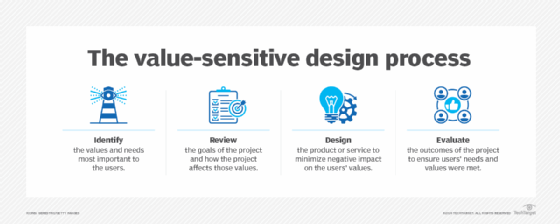What is value-sensitive design?
Value-sensitive design is a concept that advocates the consideration of human principles and standards when planning technology.
VSD brings human values to the forefront of the technical design process, providing technologists, designers, business leaders and others involved in developing technology with strategies for identifying and incorporating human values into the design and development process. Value-sensitive design aims to consider the values not only of the users, but of all others affected by the technologies -- regardless of whether those individuals will ever actually use the technologies.
VSD advises designers and developers to consider the values of direct stakeholders as well as indirect stakeholders. For example, a caller using a cellphone is a direct stakeholder. The indirect stakeholders are the individuals surrounding the cellphone user who might be bothered by the phone ringing in a quiet space or by having to involuntarily hear the contents of the cellphone user's conversation.
VSD was created in the late 1980s by Batya Friedman and Peter Kahn at the University of Washington for the explicit purpose of factoring human values into design processes. The idea was to emphasize ethics as a meaningful consideration in the design of technology.
What are the 3 phases of VSD investigation?
In addition to being a concept, VSD is also a methodology for developing technologies in a way that considers and addresses the values of direct and indirect stakeholders. It's broken down into the following three areas of investigation:
- Conceptual. Developers begin to identify the direct and indirect stakeholders and how the planned technologies might affect their values.
- Empirical. Developers confirm, expand and tweak the ideas developed in the first phase through investigations using surveys, interviews and other methods.
- Technical. The information gathered is used to shape the final product.
What are the steps in the value-sensitive design process?
The following essential steps are involved in the VSD process to develop a new product or service:
- Establish the users' values. To design with the users' values in mind, those values must first be understood. This discovery process inherently comes up front.
- Connect the design to the values. In considering the design and development of the new product or service, list the various ways that it might positively or negatively interact with the values of the users.
- Design with those values in mind. As the design is undertaken, take care to ensure what's being designed won't have a negative impact on the users.
- Confirm that the design has succeeded in capturing the users' values. Evaluate the product or service that has been designed with attention to whether its impact on the users has the intended effect, with respect to values.

Trends and challenges of VSD
The goal of VSD is to develop technologies that respect the values of all those affected by them by identifying and addressing those values early in the development process, thereby limiting or eliminating potential problems once the technologies have been deployed. However, value-sensitive design can conflict with the desire to bring products to market quickly, as VSD requirements add extra steps to the development process.
VSD and similar approaches such as design thinking are gaining a larger following, with individual designers as well as companies educating their employees more about this concept and methodology. In addition, the concept of VSD is expanding beyond IT to other disciplines such as civil engineering and transportation systems.
Critics of VSD initially noted that it fell short of its intended mark due to its failure to build around moral values considered universal -- human well-being, justice and dignity. Friedman, in partnership with University of Washington professor David Hendry, responded by updating the VSD paradigm to commit to these values. Their book, Value Sensitive Design: Shaping Technology with Moral Imagination, published in 2019, is designed as a resource for designers and researchers working to bridge technology and society.
Even so, VSD might fail in the domain where it's arguably needed most urgently -- the ongoing design of artificial intelligence. Human-computer interactions that include AI systems might be problematic where the inculcation of value sensitivity is concerned, given that machine learning-based AI is capable of absorbing markers of values to which a specific product or service's users might not be amenable, despite initial VSD efforts.
Learn how organizations are using AI in their project management workflows.







